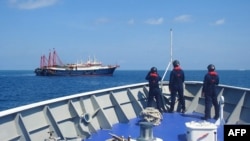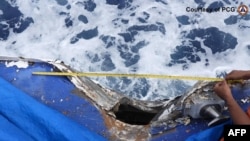Analysts say the latest collision between Chinese and Philippine coast guard vessels near a disputed reef in the South China Sea is part of a campaign by Beijing to force Manila to soften its position. They say it also raises questions about whether the two can maintain calm, despite reaching a temporary agreement to avoid clashes in July.
Monday's incident, which left a gaping hole in a Philippine coast guard vessel, occurred near Sabina Shoal, an area that lies within the Philippines exclusive economic zone, or EEZ. China says the partially submerged reef is part of its territory.
“China is trying to intimidate the Philippines and compel them to roll back their coast guard presence around [the contested reefs in the South China Sea],” said Collin Koh, a maritime security expert at Singapore's S. Rajaratnam School of International Studies.
Koh said Monday’s incident around Sabina Shoal is the first reported clash near the reef, and shows that the Chinese coast guard is using a systematic approach to impose its territorial claims near three major flashpoints in the South China Sea, including the Second Thomas Shoal, Scarborough Shoal, and Sabina Shoal.
“These clashes are no longer isolated incidents because the Chinese are using systematic approaches around the three flashpoints with the Philippines,” Koh told VOA by phone.
China claims almost all of the South China Sea, a main international trade route, including areas around Sabina Shoal. This is despite a 2016 ruling by the Permanent Court of Arbitration in The Hague that China’s claims have no basis in international law.
Video evidence
Much like previous incidents around Second Thomas Shoal, Monday’s incident occurred when two Philippine coast guard vessels, Cape Engano and Bagacay, were on a resupply mission for personnel stationed on Flat Island, which Manila calls Patag, and Lawak Island, which Beijing calls Nanshan.
Cape Engano first collided with a Chinese coast guard vessel at 3:24 a.m. on Monday, and another Chinese coast guard ship rammed the Philippines’ Bagacay 16 minutes later.
Manila accused the Chinese coast guard vessels of conducting “dangerous maneuvers” that caused serious structural damages to its vessels, while Beijing said the Philippine vessels “deliberately collided” with its ships despite repeated warnings.
Both sides released video footage to support their accusations, and some experts say Beijing’s swift release of visual materials, three hours after the incident happened, reflects the Chinese government’s efforts to counter Manila’s narrative about the collision.
“We’ve seen a bit of adjustment on both sides when it comes to releasing information about these incidents, but China has become much faster about putting out its version of events, making [Manila’s response] seem slow,” Ray Powell, director of Stanford University's Gordian Knot Center for National Security Innovation, told VOA by phone.
Despite its relatively slow response to Monday’s incident, Koh in Singapore said Manila’s attempts to share information about the collisions were still more effective.
“The Chinese are trying to copy what the Philippines were doing [in terms of releasing videos and images of the incidents,] but they are not doing it effectively since they haven’t allowed any media outlet, including Chinese state media, to take part in their coast guard operations,” he told VOA.
On the contrary, Koh said the Philippines has let local and foreign media outlets embed in their patrols, which helps increase the transparency of the information they share and make their narrative of the collisions seem like “a more convincing proposition.”
International support for Manila
Although Beijing has tried to frame the Chinese coast guard’s conduct as “legitimate and restrictive measures,” several nations quickly condemned China’s actions and expressed support for Manila’s attempt to defend its territorial interests.
In a statement, the U.S. State Department referred to “the dangerous actions by the People’s Republic of China [PRC] against lawful Philippine maritime operations in the South China Sea.” It added that the Chinese vessels’ actions were examples of Beijing “using dangerous and escalatory measures” to enforce its “unlawful South China Sea maritime claims.”
The top diplomats in the Philippines from Japan, Germany, New Zealand, the United Kingdom, and Australia all issued statements condemning the Chinese behavior, as well.
Since late last year, the Philippines has been working to strengthen cooperation with other democratic countries to safeguard its territorial claims in the South China Sea.
In response, Beijing has increased the frequency of its own joint combat patrols near the disputed reefs, conducting a joint naval exercise with Russia in the South China Sea in July.
Some analysts say the increased frequency of patrols carried out by Manila and Beijing may heighten the risk of miscalculation in the South China Sea.
“The Chinese strategy is to try to push the adversary into a position where they may make a mistake and that might give Beijing the justification for using greater amounts of power,” Stephen Nagy, a regional security expert at the International Christian University in Japan, told VOA by phone.
However, Koh said Beijing is unlikely to elevate tensions with the Philippines into a serious military conflict.
“Since a potential conflict in the South China Sea could have a knock-on effect on [its attempt to reunite with] Taiwan, which remains Beijing’s grand prize, I don’t think the Chinese would be keen to pick up a war in the disputed water,” he told VOA.
The quick escalation of tension between China and the Philippines comes after both claimed to have reached an agreement to halt fierce clashes near Second Thomas Shoal in July.
Koh said this shows the possibility for Beijing and Manila reaching a sustainable de-escalation mechanism in the South China Sea is very low.
“Both sides have differing interpretations of their respective claims in South China Sea, so they are not prepared to roll back their positions,” he said, noting that conditions for recurring clashes will likely persist in the near future.
















